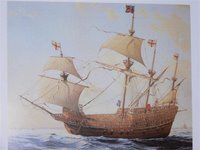 There has long been a rumour that Henry V111’s ship, the Mary Rose sank on her maiden voyage.
There has long been a rumour that Henry V111’s ship, the Mary Rose sank on her maiden voyage.This is not true.
Launched in Portsmouth in 1511, from 1512 to 1514 she faught the French in the English Channel off Brest and Cherbourg.
In 1513 she was engaged against the Scots off Newcastle
During the second French Wars, 1522 to 1525, she was again fighting at sea, and it was when she was about to sail against the French, in 1545, that she sank not more than two kilometres from Portsmouth harbour.
There she sat for well over 400 years, her keel and starboard side encased in a protective layer of Solent silt.
The Mary Rose was lifted to the surface in 1982 from which time restoration work has been ongoing.
To visit to the Royal Naval Dockyards at Portsmouth to take in the sheer magic and majesty of the three vessels housed there (The Victory, The Warrior and the Mary Rose), to ingest all the information available, is wishful thinking.
I left my viewing of the Mary Rose to last, I suppose because the shed she is housed in is not as inviting as a two tall ship sitting in a dock in front of you.
Now I wish I had had given myself more time.
Consider the Mary Rose, a purpose built warship, built almost entirely of oak.
Consider life on board in the early 1500s – as revealed by the thouseands of artefacts brought up with the ship.
Consider the men who sailed her – the mariners who earned 6s 8d a month (1545).
Consider the perilous tides and currents of the Solent which can toy with today’s vessels, vessels equipped with the latest in navigational equipment. For any ship to sail in and out of these waters was a feat all of its own.
When the Mary Rose went down, for as yet unknown causes (though several have been postulated), she took most of her crew of 385 (at least) with her.
The remains of 200 of these men were uncovered within the wreck, the majority being healthy young men in their late teens or early twenties.
Note on photo: Though I tried to photograph the ship though the Perspex walls and treatments mists of its sealed environment, my attempts were unsuccessful for reproduction here. I have therefore taken the liberty of photographing the ship from the Mary Rose, Museum and Ship Hall book, which I purchased during my visit.
No comments:
Post a Comment